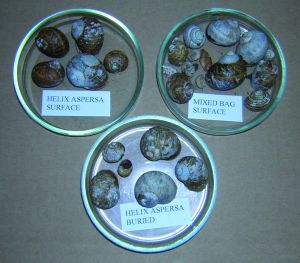|
When studying the populations of snails, use if often made of the presence of fresh dead shells; i.e. with outer protein periostracum layer still present. The shells themselves are believed to survive many years, even decades in the surface soil layers if the soils have a high pH. Chalk rich soils help preserve the shells from decay for hundreds or even thousands of years, and are extremely useful to help determine earlier environmental conditions. Several authors (e.g. Evans 1972, Cameron & Morgan-Huws 1975) state that the periostracum decays within a year. This would mean that shells with periostracum still present could indeed be counted as fresh and would be useful in population studies. But I have been unable to find evidence to back this very reasonable assertion. How much periostracum would be needed to be called ‘intact’, given that some lose the periostracum on their apex while they are alive? The decay of periostracum could be caused by chemical attack, abrasion, bacteria, temperature fluctuations, other snails grazing and other reasons. It would be affected by the pH of the soil, whether buried or exposed to the sun and rain. I was determined to test how long the periostracum really did survive in the fairly neutral soil developed from Weald clay, in my garden. Twelve live Helix aspersa were killed and the bodies removed and divided into two groups in plastic mesh bags. One bag was buried just under the surface of the soil and the other was left on the surface in a relatively undisturbed part of the garden under a fig tree. Another bag of mixed already dead shells, but with complete periostracum was left on the surface. They were exposed to frost and rain in winter, and sheltered from the worst of the summer sun. The results were as follows: Experiment started 28th December 2002. 4 weeks later after much rain and frost those on the surface were already starting to show pitting of periostracum, but those buried were still largely intact. 23rd December 2003 Buried bag: two mature Helix lost 25% and 40% of periostracum on apex and last whorl. Two smaller Helix: one lost 10% from apex and the other 60% mainly from last whorl. Two juveniles; one lost 5% from apex, the other lost 50% flaking off all over the shell The freshly killed surface bag: 2 mature Helix – one lost 10% around apex and 10% on underside (total 20% gone), the other lost 90% with only the most recent part of the shell still with periostracum. The other four had lost; one less than 5% from apex; two had lost 5% from apex and 5% from base of last whorl (total 10%), one 5% on apex and 10% on base (total 15%). One juvenile was still largely intact. Mixed bag: 8 Helix showed losses between 15% and 90%, mostly on apex and underside. 3 Cepaea; virtually intact; 10% loss and 95% loss respectively 3 Trichia striolata had all lost the periostracum 2 Monacha cantiana had lost 5% on apex and 10% but apex still intact respectively. 10th November 2005 Buried bag, 6 Helix had all lost 90% of periostracum. Unburied Helix, now only 5 shells remained, one had lost 90%, one lost 50% and three lost about 15% The unburied mixed bag, 16 shells reduced to 10 plus fragments: two Cepaea, two Helix and one Monacha had lost 90% of periostracum. one Helix had lost between about 75%. 2 Helix and one Cepaea had lost 30% and the two Trichia still survived with total loss of periostracum. So after three years some of the unburied shells still had as much as 80% of the periostracum intact. Despite initial results the buried shells seemed to lose the most periostracum, suggesting damp and bacteria may have more impact than surface weathering. Anyone fancy doing a long term experiment with different soils and leaf litters and different levels of aerial exposure? Refs: Cameron, RAD, Morgan-Huws, DI, 1975, Snail faunas in the early stages of a chalk grassland succession Biol. J. Linn. Soc. 7: 215-229 Evans, JG, 1972, Land Snails in Archaeology |
Fig 1 Periostracum experiment (Photo Amanda Millar) |
How long does periostracum last after the death of the snail?
Issue
10
Page
17

